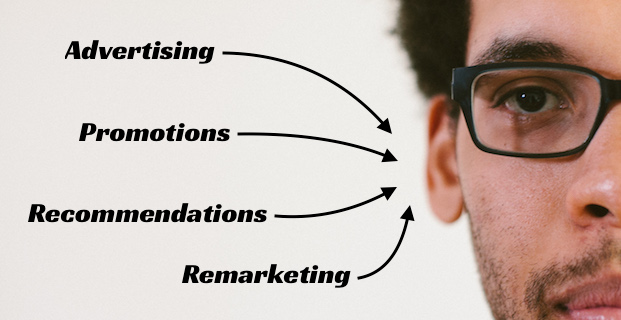by Mark Bloom | Oct 10, 2017 | Agency Advice
Agencies Should Consider the User Experience
As Ray Access has written previously, a business website should turn visitors into customers. That’s its job. To get to that point, however, you have to follow a process — steps that do all the right things to encourage visitors to engage. But that process is more of a varying checklist than a straightforward procedure. Every website’s a little different.

You know when you get it right. As a developer, designer or marketer, your clients love you when their websites work. All businesses love to hear, “I found you online.” To them, it means that the investment in a website is paying off.
A Tall Order for UX
While the rewards of creating that perfect website are profitable and fulfilling, it sometimes feels like hit-or-miss. It’s all about the user experience, known in the industry as UX. A positive online user experience is more likely to gain leads, get referrals and make sales. The websites you build for your clients have many jobs to do; they must:
- Welcome new visitors and returning customers
- Have a pleasing design that inspires longer visits
- Provide clear navigation to pertinent information
- Establish your client’s expertise in their field
- Define exactly who your client’s target audience is
- Announce their unique value proposition to that audience
- Generate trust in every visitor
- Answer questions about your client’s industry, company, products or services
Why Your Clients Want a New Website
Unless you’re a small business that targets startup companies, most of your clients already have a website. They’ve likely invested thousands of dollars for the design and development of their site. Part of your sales process is to sell them on the idea of upgrading and updating their website. Is it part of a larger rebranding effort? Is it time to update so the company doesn’t look dated? These are issues you may deal with every day.
Ultimately, every business decision has to benefit the business. Companies don’t spend money on a new website if they don’t think it has any value. They want their website to build their brand awareness and contribute to their bottom line. In other words, a new website has to show a return on investment.
How UX Solves These Issues
User experience increases the odds that a new website is successful. By considering UX in every website project, your agency will check off every one of the items in the list above. Your clients are more likely to see the return on investment (ROI) on their new website if it’s been optimized for the user experience. That translates into more referrals for your business.
When it comes to building and designing your clients’ websites, you know you have to satisfy their visitors and customers. You always have to consider the human elements and interactions. People make your clients’ websites successful, not code or backlinks. Ultimately, a business website isn’t even about the business. Instead, a business website is a service for readers, visitors and customers — the people who buy from your clients.

Where to Find UX Services
User experience isn’t exactly a new field. It used to be called “human-computer interaction” and “user interface design.” In some circles, it still is. Ray Access offers a service to provide a UX review called website assessments. A website assessment is a page-by-page review of a business website from the point of view of a visitor. It’s human factor testing on a human scale.
You can use Ray Access as a beta tester for a new website or even a new website design. Get a website assessment report even before your client sees it. Make it part of your process. It’s an affordable service that you can pass on to your clients without raising an eyebrow. It can fit neatly in your package costs. User experience testing can become part of your sales kit, especially since it’s a service few of your competitors may offer.
What Ray Access Brings to the Table
As content providers and content marketers, the Ray Access writers and editors review websites all day every day. The user advocates at Ray Access understand how people look at websites — they know what visitors look for and what drives them away. And they’ve developed a critical eye for what makes a business website successful.
A website assessment report doesn’t roll over the work you’ve already done on a website project. Instead, it:
- Identifies missed opportunities — either prominent information or needed pages
- Highlights what works well — design- and content-related
- Identifies issues with the navigation — how easy it is to find information
The report shows how, with a minimum of effort, you can improve the website exponentially. A website assessment — performed as part of your beta testing, before the site is brought online — happens at a time when you still have your resources devoted to the project, so changes can be made relatively quickly and painlessly. Contact us today to find out more about website assessments.
Ray Access is a content marketing firm that delivers targeted words to empower your business. Contact us about your specific project to receive a quote or discuss your needs. We write website copy, blog posts, e-newsletters and more. Everything we do is thoroughly researched, professionally edited and guaranteed original.
by Mark Bloom | Sep 25, 2017 | Small Business Advice
Our Mission Statement Gives Us Our Purpose

At Ray Access, we don’t often use this platform to toot our own horn, not counting last week’s cool announcement. But we take our mission statement seriously. It drives our business forward and expresses our ethics. In short, it gives us our purpose. Without it, Ray Access would be a rudderless ship adrift in an ocean of opportunity. Read it for yourself:
“To help companies succeed online while educating business leaders about the value and purpose of well-crafted content. It’s not enough for you to say something; you have to say something meaningful. Your message must be worth your customers’ time and attention.”
We’ve written about mission statements before. Finding your mission and putting it into a statement can point you, your business or your agency toward:
- The success you crave
- The clients you want
- The work you desire
Every Day Is an Opportunity
Many companies don’t change a thing after spending time and effort writing their mission statements, but that’s not how mission statements work. Once you have your purpose, it’s supposed to change your approach to your job, your idea of success and your list of priorities. The most successful companies have actionable, goal-oriented mission statements. We’d bet these companies have placed their mission, clearly and visibly, on the walls of their reception areas, in the company cafeterias or break rooms and in the offices of the CEO.
You need to live your mission statement. You need to refer to it often. Let it guide your decisions and keep you on the right path. Your mission, just as the word itself implies, is your reason for being in business. If you ignore it, you have no purpose other than making money, and if that’s your true purpose, you’ll end up making short-term, profit-motivated decisions that may short-circuit your ultimate success.
Ray Access Lives Up to Its Mission Statement
It’s not easy to live your mission. But, as one CEO said: “Do the right thing, not the easy thing.” By staying true to our goals and purpose, Ray Access is attracting the kind of business clients we’re seeking. We’re finding writers who want to stay with us and contribute. Anyone, be it client or contractor, who doesn’t align with our vision, ends up leaving.
And we’re fine with that. We encourage it, in our own way. We’d prefer to surround ourselves with those people who want what we want:
- To help businesses become successful through top-notch content that connects with customers
- To create literate marketing messages that attract a more targeted customer base
- To educate business leaders to develop a more media-aware marketplace, where both businesses and consumers understand the value and power of knowledge
- To inspire people to fashion a better and safer digital world for businesses and consumers alike

Evolving Needs to Hit a Moving Target
But the world is changing. New technologies come along that disrupt the status quo. New platforms emerge that better connect people to what they want. New algorithms allow search engines to determine which messages are the most valuable. Through it all, Ray Access has been saying that it’s quality content that matters most.
And that’s still the case. Regardless of search engine algorithms, keyword best practices or the number of backlinks — all that SEO mumbo-jumbo — it’s really all about delivering value to your audience:
- Answering their questions
- Gaining their trust
- Proving your expertise
- Communicating clearly and honestly
We write informative website copy, engaging blog posts and attention-grabbing newsletters for our clients. We write for people first, because people matter most. It’s not necessarily the companies who are the biggest spenders who end up winning; it’s the businesses with the best messages that come out on top.
Writing is still meaningful. Communication is still vital. Businesses still thrive — or fail — based on how they connect with their audiences. So, when you’re in the market for revamped website content or when you’re ready to launch, or relaunch, your blog, remember Ray Access.
Ray Access is a content marketing firm that delivers targeted words to empower your business. Contact us about your specific project to receive a quote or discuss your needs. We write website copy, blog posts, e-newsletters and more. Everything we do is thoroughly researched, professionally edited and guaranteed original.
by Mark Bloom | Sep 4, 2017 | Content Provider
Attract and Retain Your Newsletter Subscribers
Businesses, agencies and internet marketers are turning to email newsletters to stay top-of-mind with their customers and potential customers. A successful newsletter for business effectively keeps your customers:
- Up-to-date with changes in your industry
- Educated about the products and services you provide
- Aware of your brand’s unique value proposition

A newsletter is a cross between a press release and a blog post: it either announces news or offers informational content your customers can’t get anywhere else. But blog posts are often weekly articles published on your website, and press releases go out to the media only when you have important news to share with your community. A newsletter, on the other hand, is a monthly or quarterly update sent directly to your list.
To Make Your Newsletter Successful
First of all, never waste your customers’ time. Don’t send out a newsletter unless you have something to say — something that’s not: “Here’s what’s on sale this week!!!” You’re sending an email directly to people who already like you. Make sure what you have to say interests them, or they’ll unsubscribe faster than you can say “SEO.”
A successful newsletter appeals to your subscribers right away — so it begins with the subject line. Find a topic your customers want to know more about and entice them with it. Instead of “Our Monthly Newsletter,” get right to the heart of your content:
- Learn How to Write a Successful Newsletter!
- 3 Steps for Adding Value to Your Customers’ Lives
- You Can Sell More with These 5 Easy Steps
Content Is Still King for Successful Newsletters
If you get the topic and the subject line right, your subscribers will at least open your email. Then you must deliver on your promise. Spend time connecting with your audience — which is why you really need to know who they are and what they want. A successful newsletter, delivered consistently, can help you establish trust. To be read, though, your newsletter content has to deliver:
- Useful information — tips or practices that your customers can use right away
- Entertaining stories — impactful tales from your business or industry
- Relevant news — whatever’s happening that your audience may find interesting
Keep your content to a reasonable length. If you send out a newsletter more frequently than once a month, it needs to be very short and to the point. Your subscribers don’t have time for much more than a few paragraphs. If your newsletter is monthly or quarterly, it can be longer, 300 to 500 words. In these cases, though, help readers by placing a list of contents at the top so readers know what to expect.

Formatting Matters
Yes, text size is important so that your newsletter is readable, but make it easy and fun to read. Add photos, graphics, charts and tables whenever possible. They impart information, and they can be fun to scan. Also, make liberal use of bulleted lists and numbered lists. Lists help break up blocks of text and are also easily scannable.
Perhaps the biggest piece of advice, though, is to be sure, beyond any doubt, that your email newsletter template is mobile friendly. More and more, people are checking their email on a mobile device. If your newsletter doesn’t translate well to a smart phone, look for another template. Otherwise, only the minority of readers on a desktop or tablet will read your words.
Wrapping It Up
As Ray Access has reminded you before, your newsletter shouldn’t be a sales pitch. But it’s perfectly acceptable, after you’ve provided something of value, to offer an incentive or special deal. Prove that you value your newsletter readers with a special offer not available anywhere else.
Finally, provide a single call-to-action button or link. If your newsletter is about successful newsletters, for example, offer them a reduced price (say 25 percent off) for one. Get readers to take an action, such as contacting you for the deal. In fact, if you contact us, we’ll make that offer right now! Good luck with your newsletter; remember Ray Access is always here to help.
Ray Access is a content marketing firm that delivers targeted words to empower your business. Contact us about your specific project to receive a quote or discuss your needs. We write website copy, blog posts, e-newsletters and more. Everything we do is thoroughly researched, professionally edited and guaranteed original.
by Mark Bloom | Aug 22, 2017 | Content Provider
Newsletter Writing Tips You Can Use Right Now
As more and more companies send out newsletters to their customers and potential customers, it becomes increasingly more difficult to stand out from the clutter. Newsletters arrive by email, where they run the risk of:
- Being taken for SPAM
- Being deleted right away
- Never being opened or read
- Being unsubscribed
You need to put care and effort into every newsletter you send out to prevent those negative responses. A sloppy, “Here’s this week’s sale” announcement won’t cut it. Subscribers catch on quickly when month after month, you try to pass off a sale as news. Newsletter writing tips help you engage your audience and hold their attention. Newsletters provide a direct way to connect with your audience — but only if they read them.

The Newsletter Writing Tips You Need
Follow these newsletter writing tips, and you’ll get positive feedback instead of unsubscribe messages. Check these tips against every issue of your newsletter:
- Know your audience. This information is at the core of every successful piece of writing, from a Stephen King novel to your newsletter. You know who your customers are so you can sell your products or services to them; use that same demographic information to write to them.
- Discover what they want. Do your research. Find out who’s subscribed to your newsletter and what they’d like to learn about. Find out what questions they have about your business or industry. Ask them. Poll them. Send surveys. Look at your competitors. Get creative.
- Give your readers something valuable. In other words, don’t try to sell your wares from the get-go. If you’re not providing value to your readers, your readers aren’t going to buy anything, including your free newsletter. Give them something they want, and they’ll pay attention.
- Use intriguing titles. Say what you want to convey, but say it in a way that elicits an emotional reaction. Instead of “Newsletter Writing Tips,” use “15 Newsletter Writing Tips to Make Your Next Newsletter Better!” Make it personal. Make it immediate. Make it relatable.
- Deliver on your promises. Don’t become clickbait; if you promise newsletter writing tips, deliver them. Add value to your readers’ lives, and they’ll become loyal readers who look forward to your next newsletter. Drone on and on about an unrelated topic, and they’ll drop you faster than last week’s gossip column.
- Write like a journalist. This doesn’t mean writing in a dry tone with just the facts. It means use the inverted pyramid style of writing, in which you put the important points of information at the very top of the article. Not everyone will read to the bottom.
- Write with personality. People buy from people and companies they like. Present your likeable self in your newsletters. Yes, be informative, but do it with style. Use the language of your audience, but write it in your own voice.
- Stay on topic. Each newsletter should have a single theme or focus. Write about that and cover it completely. At the same time, keep your newsletters short — as short as 350 words, or the size of a short article. Never exceed 750 words. It’s not a newspaper; it’s a newsletter.
- Always include images. Newsletter writing tips aren’t just about writing. No matter how engaging your writing is, it looks lifeless without images. Photos, graphics, charts and tables can brighten up your newsletter, making it easier on the eye and even more informative, as pictures convey non-verbal meaning.
- Use images that stand out. Be careful of using stock images that everyone’s seen 100 times. Look for images that are different. Maybe develop a standard (such as a tint, crop or shading) that identifies your brand.
- Employ statistics and quotes as needed. Did you know that 60 percent of marketers use newsletters to reach out to their clients? Statistics and quotes lend authority to your subject. Sprinkle them in to strengthen your own points.
- Include links back to your website. Newsletters help you keep in touch with your customers and potential customers, but your website is the online hub of your business. Direct your readers to your website and blog, where they can learn more about your company, your products and your services.
- Don’t link to other websites. Your newsletter is not the place to corroborate your statistics or source your quotes. You don’t want to send your readers to someone else’s website. Keep readers engaged in your newsletter and just link to your own website.
- Include one, and only one, call to action. Like your website, your newsletter shouldn’t be all about you and your company. It should be about your audience — your customers and potential customers. Provide content readers look for and trust, and they’ll turn to you when they’re ready to buy.
- Be sure to spell check. Actually, using spell check isn’t enough. Reread your newsletter, both before and after you’ve formatted it. Double-check everything. Have someone else read it too. Put it aside overnight, and then read it again in the morning. You can’t afford mistakes.
A newsletter only works if you send it out. So, do your best and let it go. Keep refining your formula with every issue — whether that means better targeting, better headlines, better images or better content. The team at Ray Access hopes these newsletter writing tips help you improve your reach and satisfy your customers. If you need help with your newsletter, contact the writing pros at Ray Access.
Ray Access is a content marketing firm that delivers targeted words to empower your business. Contact us about your specific project to receive a quote or discuss your needs. We write website copy, blog posts, e-newsletters and more. Everything we do is thoroughly researched, professionally edited and guaranteed original.
by Mark Bloom | Aug 8, 2017 | Agency Advice
Web Developers: Write the Content for Clients
If you own or work for an internet agency — such as a web development firm, an SEO marketing concern, a branding or design company or in-house marketing department — you provide services to your clients to:
- Develop an online presence or storefront
- Get them noticed online
- Generate traffic to their website
- Attract the “right” audience, those who already may be looking for their products or services
- Help them convert those visitors into paying customers
- In general, help them succeed

How well you succeed is measured by your clients’ return on investment and increase in brand awareness. In other words, the better your clients do, the better you look. If you want referrals, that gold mine of qualified leads, then you must deliver satisfaction.
Why Content Matters
You know the answer to this already. But remember that content can include words, pictures and videos. Content is anything visitors can consume — anything that answers their questions or engages their minds … or their funny bones. Content can take many forms; it depends on its purpose and its intended audience.
Online content for clients — whether for their website, blog or social media — must fulfill its purpose:
- Attract those people or businesses who may be interested in your clients’ products or services
- Answer their questions about your clients’ business or industry
- Generate trust in your clients’ business
- Persuade visitors or readers to contact your clients
Why Your Clients Shouldn’t Write Their Own Content
Obviously, creating videos, photos and graphics takes specific skills — skills your clients may not possess. But anyone with a computer can write. Your clients may insist on creating their own written content. Here’s why you should stop them and deliver content for clients as part of your services:
- Content delay. The number one reason to avoid letting your clients write their own content is that they may never actually do it. They may have good intentions. They may think your deadline is far enough out to make the project feasible, but crises are a part of business, and website content often gets pushed down to the bottom of the priority list. When the deadline comes and goes, it becomes content delay, and suddenly, it’s your problem.
- It’s marketing. Unless your clients have a full marketing department, they may assign the task of writing the content to the wrong person. A website, blog or social media isn’t necessarily a platform for advertising or customer service. Sure, those things matter, but not as much as marketing: building their brand awareness, nurturing their potential customers and generating an online presence that can stand out. Online content has to connect with its intended audience.
- Quality suffers. Your clients may know their business inside and out. They may know their customers top to bottom. But they may not know how to approach online content writing. When you produce the content for clients, you provide what they need, instead of what they want. You know what it takes for your clients to succeed in the online environment. And if you don’t, you know you can find a third-party subcontractor like Ray Access who does understand the online world and can deliver content for clients of every industry.
- Differences abound. Your clients understand the difference between video and photos, but they may not understand the difference between website content and blog posts. These two platforms serve different functions. If your clients write blog posts as web pages or web pages for blog posts, they won’t succeed. You need to step in to create the kind of content for clients that works for its intended purpose.
To truly stand out, your clients need good, effective content. If you can deliver that for them, your firm can also rise above the crowd in a competitive market. You can only do that by taking charge of the project. Don’t let your clients write their own content.
Ray Access is a content marketing firm that delivers targeted words to empower your business. Contact us about your specific project to receive a quote or discuss your needs. We write website copy, blog posts, e-newsletters and more. Everything we do is thoroughly researched, professionally edited and guaranteed original.
by Mark Bloom | Jul 18, 2017 | Editing
Effective Editing Makes Writing Easier to Digest

Editing isn’t a magic wand; it’s a process that involves insight, intelligence and hard work. But before getting to the seven secrets of effective editing, it’s helpful to define the term, so you understand exactly what this article refers to as editing.
The Difference Between Revising and Editing
Effective editing can streamline and refine any piece of writing. Editing takes the author’s intent and sharpens it to better relate to its targeted audience. Revising, on the other hand, requires rewriting the article — which in this case includes blog posts and website content — to better reach its goal. Revising is usually, but not always, done by the author, and it can be an extensive process.
When an article is 90 percent there, editing tightens up the writing and smooths out the wrinkles. When an article is only 50 percent there, it may need more research, more content or even a different approach. In this instance, editing can’t help. It needs to be revised.
The Secrets of Effective Editing
Here are the seven secrets of great editing, as promised. When you work with editors, professional or otherwise, look to see if they deliver results in line with these practices:
- Create concise language. In general, writers hate to cut any words for fear they’ll lose the magic of their prose. Writers love the sound of their own words. Editors don’t suffer from that delusion. Readers’ feelings matter more than writers’ feelings. So — cut to fine-tune the message.
- Choose better words. The right word makes all the difference. Very often, one strong word works much better than a wordy phrase or group of less powerful words. The right word connects better with readers, delivers more of an emotional impact and creates a sense of action. Editing word choices also contributes to Secret #1. So — spend the time to find the right word.
- Develop strong openings. The introduction to any piece of writing should be the last section edited. It needs to feature strong writing that draws in its intended audience, and that can only be done when the editor knows what the article is about. As they say in the newspaper business, “Don’t bury the lede.” So — refine the opening until it sings.
- Let it flow. Every article needs to lead readers from point to point. The writing must flow effortlessly and logically. Sometimes, whole sections need to move up or down to facilitate that flow. Sometimes, sentences fit better elsewhere. So — make sure nothing gets in the way of a good read.
- Break it up. Make sure that the blog post or website page has sufficient subheadings. Almost everyone scans content online. Make it easy for readers with descriptive, short but clever headings that let readers know what’s coming. So — keep every section short, adding headings as needed.
- Double-check the heading text. The title and the headings in any article can spell success or failure. There are whole books written about creating effective titles. Just make sure it’s not clickbait. Instead, create titles and headings that add personality to the piece. And deliver on your promises. So — revise the title and headings as needed to engage readers.
- Read it through a second time. Most editors realize they are the last stop on the road to online publication. The edited article needs to be clear and concise. Effective editing requires a second read-through to catch any typos, omissions or other errors. So — read through the entire article once more before letting it go.
Nothing written is ready for publication until it’s been edited. Effective editing can make the difference between viral and valueless. If you follow all these editing tips in your writing process, you’ll deliver outstanding and effective content to your — or your client’s — website.
The team at Ray Access believes in editing as part of the writing process. Every blog post, website page, press release and newsletter we deliver to a client has been professionally edited. Now you can hire the pros on the Ray Access team to edit your business writing.
by Mark Bloom | Jul 4, 2017 | Content Marketing
Content Marketing Strategy Requires Promotion
First, keep in mind that content marketing works. It brings traffic to your business website and converts visitors into customers. It works over time as you add content and answer questions your customers are asking about your business or your industry. The relevant statistic is:
74 percent of buyers choose the company who first answered their questions.
As writers and producers of website content and blog posts, the team at Ray Access has seen its share of amazing successes. For instance, one client, a tent and party rental company, claimed to have lost money the first year we wrote content for them because they were unprepared for the onslaught of customers — they had to pay their team lots of overtime just to keep up.
Not Every Client Experiences Sudden Growth
Content marketing alone doesn’t always produce immediate results like this client experienced. To ensure success, you need to develop a content marketing strategy. Content marketing needs to be part of the picture, but not the whole picture.

The rules have changed, and the internet no longer provides a blank check. While it’s a level playing field — meaning small companies can compete with larger ones — you now have to do everything you can to get noticed. You have to promote your content and follow good SEO practices.
Outreach and Onsite Marketing
So, when you put together a content marketing strategy, you have to include the practice of promoting your website content. You have to push your blog posts and press releases out into the world. You have to deliver them to the platforms, whether on social media or complementary websites, where your prospective customers are spending their online time.
And still that’s not enough. You have to optimize the content on your website not just for search engines, but also for conversions. If you advertise online, you need carefully constructed landing pages to reinforce your value. Attracting qualified leads is just one job of your website. If those leads don’t find what they’re looking for, they’ll leave and never come back.
What’s Your Content Marketing Strategy?
If you don’t have one, you’re not empowering your website to do its jobs to its fullest capacity. If you haven’t developed personas, do you really know who your customers are or who’s really buying your products or services? A content marketing strategy:
- Points you in the right direction to gain customers
- Helps you develop the content those customers are seeking
- Provides the topics your customers and potential customers need to follow you from awareness to sales
- Clearly directs readers to purchase your goods or services
You can do all this work in-house, assuming your marketing team can handle the load and has the marketing expertise, or you can hire various third-party vendors to watch your internet back. Without a plan, you’re shooting blanks into a barrel of water instead of arrows into the minds of those you want to attract. Your marketing plan needs a content piece to guide your work.
If you need any help, contact Ray Access. Expert at content development, the principals of Ray Access can help you develop the right content to the right audience at the right time. To find out what it may cost, read How Much Does Website Content Cost?
Ray Access is a content marketing firm that delivers targeted words to empower your business. Contact us about your specific project to receive a quote or discuss your needs. We write website copy, blog posts, e-newsletters and more. Everything we do is thoroughly researched, professionally edited and guaranteed original.
by Mark Bloom | Jun 13, 2017 | Small Business Advice
You Must Know Your Customers to Sell to Them
Ralph Waldo Emerson once wrote: “If a man can write a better book, preach a better sermon or make a better mouse trap than his neighbors, though he builds his house in the woods, the world will make a beaten path to his door.” This sentiment may have been true in the late 19th century, but it isn’t any longer.
Today, you have to promote your brand, do your market research and offer compelling pricing. It almost goes without saying that your products or services are better in some way than your competitors’. To reach your audience in a meaningful way, you have to know who your customers are — and the better you understand them, the more your sales tactics will succeed.

Do You Know Your Customers?
Your customers include those who have already bought your products or services, as well as those who are merely interested in what you’re selling. You have to reach both of those audiences to increase your sales and grow your business. How do you find out who your customers are? Ask them, poll them or survey them. Explore your analytics. Search social media characteristics. Whatever it takes, you must do it.
It’s possible that the only difference between those who’ve already bought from you and those that haven’t is that one group already knows how awesome your company is and the other group doesn’t. Yet. You have to put the effort into getting to know your customers. Find out as much as you can about them. For example:
- What they like, beyond your products or services
- Where they like to go and where they hang out
- How much they earn, on average
- Why they like your company enough to buy your offerings
- What they do for work and play
- How old, what gender and what race they are, on average
The Point of This Exercise
To get to know your customers, research all the information above. But once you have that information, you have to act on it. You have to target your advertising and marketing to that audience. You have to be a presence wherever they are.
For example, if you determine that they’re more likely to listen to a certain radio station, buy air time. If they spend time on Facebook or another social media channel, advertise there. If many of your customers also mountain bike, drink beer or vacation in the mountains (to pick three random examples), make sure you have a presence in mountain bike shops, breweries or mountain rentals.
Success Involves Knowing Your Customers
As writers, the Ray Access team has to know who our clients’ customers are before any writing can take place. All writers need to know their audience. Stephen King, Peter Drucker and Ralph Waldo Emerson all recognized who would read their words. Fox News outlets, your local paper and the New York Times all understand their specific following. When you write your marketing copy, website content or blog posts, know your audience to get the best results.
In the end, when you know your customers, you know how to appeal to them. Because you know what they want, you can build the trust it takes to create not just customers, but loyal advocates of your brand. That’s worth taking the time to get to know your customers — both for the present and for the future.
Ray Access is a content marketing firm that delivers targeted words to empower your business. Contact us about your specific project to receive a quote or discuss your needs. We write website copy, blog posts, e-newsletters and more. Everything we do is thoroughly researched, professionally edited and guaranteed original.
by Mark Bloom | Jun 6, 2017 | Small Business Advice
No Matter What Your Business Is, Know It Well
Running a business is hard work. If you’re a small business owner, then you’re likely doing almost everything yourself. It’s a lot to take care of, all those parts of a business, and you have to do everything well. The state of your business very often depends solely on you.

As small business owners, the principals of Ray Access have found themselves in the same boat — and to maintain this analogy, you’ll agree that when you have to do everything yourself, the boat sometimes springs leaks. When you’re working, you’re not marketing. When you’re doing payroll, you’re not earning any money.
Get These Parts of a Business Right
It’s a small business trap. It’s about balance… and knowing when to call in outside help. It’s about forging ahead… without killing yourself. It’s about recognizing the value of your time.
But some things require your touch. These are parts of a business that you must understand backward and forward. These are business aspects that you have to know so well that you dream about them. And let’s be frank, when you’re starting a business or nursing a small business, you’re dreaming about it most nights.
5 Parts of a Business to Worry About
No one person has all the answers. Ray Access is no different. We advise you to read and digest the information presented below, but how you approach them may be as unique as your unique value proposition:
- Operations. No matter what your company produces — whether it’s yoga eggs or accounting services — you need stay on top of your day-to-day work. To keep your business running smoothly, you need to nail your business operations. Keep your customers happy, keep your employees happy and keep the production flowing. This is perhaps your #1 priority. Without having your finger on your company’s pulse, your business can collapse from neglect or poor decision-making.
- Customers. No matter what you sell, your customers keep you in business. It’s imperative therefore that you learn as much about them as possible. Where do they hang out? What do they enjoy? How much do they make? How old are they? Create buyer personas so that you can better tailor your wares to your best customers. Personas also help you target the most appropriate market when advertising.
- Financials. To succeed in business, you must understand the three major financial statements: profit and loss statements, balance sheet and cash flow. To know how your business is doing at any point in time, you have to know how to read these documents. Fortunately, you can find software solutions, including QuickBooks invoicing that make your financials much more accessible.
- Research. The world continues to evolve. Don’t be caught with an outdated solution to a problem that no one experiences anymore. To stay current, keep up with research in your field. Advances are overtaking almost industry. With the Internet of Things (IoT), every business is or will be changing. How will your industry evolve? That’s your charge.
- Marketing. No one beats a path to your door — most people don’t know where and how to find you. You need to keep your brand in front of your target audience. Without marketing, your business is a corner shop on a deserted street. It’s no longer enough to be the best plumber, for example; you have to let everyone in your market know that you’re the best plumber — and provide the reasons.
All five of these parts of a business contribute to the success or failure of your company. Learn them. Use them.
Ray Access is a content marketing firm that delivers targeted words to empower your business. Contact us about your specific project to receive a quote or discuss your needs. We write website copy, blog posts, e-newsletters and more. Everything we do is thoroughly researched, professionally edited and guaranteed original.












